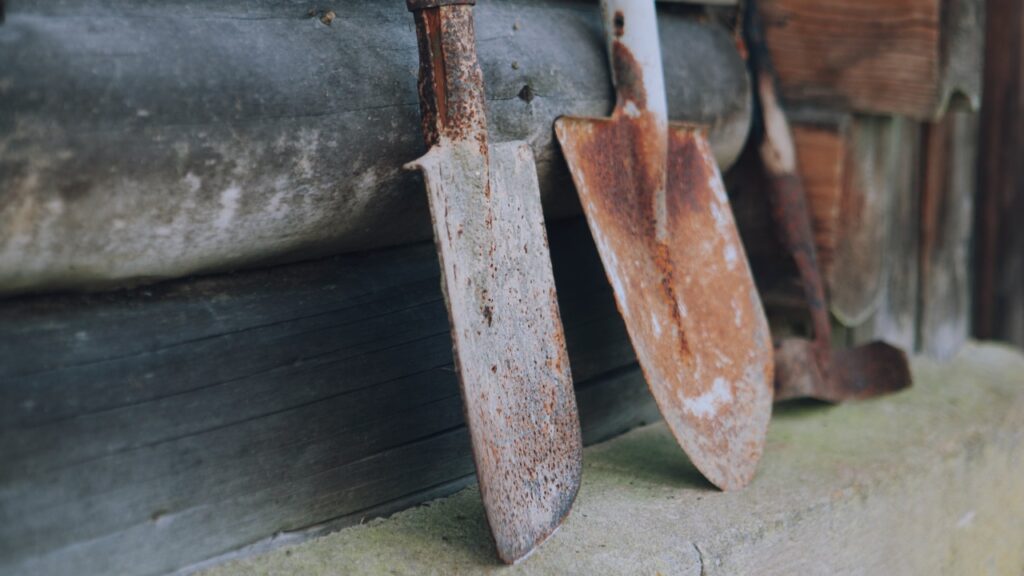The choice between a spade and a shovel in gardening depends on the specific tasks you need to perform, the type of soil you’re working with, and your personal preferences. Both tools have distinct advantages and are better suited for different gardening activities. In this comprehensive guide, we’ll explore the differences between a spade and a shovel, their respective uses, and when to use each tool. This will help you make an informed decision when working in your garden.
Spade
A spade is a gardening tool characterized by a flat, square-shaped blade with a sharp edge and a long handle. It is designed for digging, cutting, and moving soil. Here are some key features and uses of a spade in gardening:
Features of a Spade:
- Flat, Square Blade: Spades have a flat, square-shaped blade with a sharp edge. The flat blade allows for cutting precise edges and clean lines in the soil, making it ideal for creating straight planting rows and well-defined borders.
- Straight Edge: The blade’s straight edge is suitable for making deep and narrow holes, which is especially useful for planting small to medium-sized plants, such as bulbs, perennials, and annuals.
- Narrow Blade: Spade blades are narrower than shovel blades, which allows for more controlled digging and soil displacement. This is advantageous when working in confined spaces or around existing plants.
- Handle: Spades typically have long handles, which provide good leverage when digging or cutting through soil. The long handle allows for standing while working, reducing strain on the back.
Uses of a Spade:
- Edging: Spades are excellent tools for creating clean edges along pathways, flower beds, and other defined garden areas. Their flat, straight blades allow for precise edging.
- Planting Small Plants: Spades are well-suited for digging narrow and deep holes when planting small plants, ensuring that the root systems are not disturbed during planting.
- Cutting Sod: When you need to cut or remove sections of sod, a spade’s sharp edge makes it easy to slice through the turf with precision.
- Digging and Trenching: Spades are used for general digging tasks and trenching, particularly in areas where you need to dig straight-sided holes or trenches.
- Transplanting: When transplanting small to medium-sized plants, spades help you dig up plants with minimal damage to their roots.
Shovel
A shovel is another essential tool in gardening with a distinct design that sets it apart from a spade. Shovels have a curved blade with a pointed tip and are primarily used for lifting and moving materials like soil, mulch, and compost. Here are some key features and uses of a shovel in gardening:
Features of a Shovel:
- Curved Blade: Shovel blades have a curved, concave shape with a pointed tip, allowing them to scoop and lift materials efficiently.
- Rounded Edge: Shovel blades have a rounded edge, which is well-suited for scooping and moving bulk materials. The rounded shape of the blade prevents it from cutting into the soil.
- Wide Blade: Shovel blades are wider than spade blades, which provides a larger surface area for scooping and moving soil or other materials.
- Handle: Shovels typically have shorter handles than spades, which are designed to be used in a more upright or leaning position. This can be beneficial when lifting and moving heavy materials.
Uses of a Shovel:
- Digging Holes: Shovels are effective for digging larger holes and trenches in the garden. The wide blade allows for moving substantial amounts of soil quickly.
- Lifting and Moving Materials: Shovels are primarily used for lifting and transporting materials, such as soil, mulch, compost, gravel, and sand, from one location to another.
- Mixing Soil and Amendments: Shovels are handy when you need to mix large quantities of soil with compost, fertilizer, or other amendments.
- Clearing Debris: Shovels can be used to remove debris, such as fallen leaves, weeds, and plant trimmings, from garden beds.
- Creating Mounds and Berms: Shovels are useful for creating raised garden beds, mounds, and berms by moving and shaping soil.
When to Use Each Tool
Use a Spade when:
- You need to create clean edges along paths and garden beds.
- Planting small to medium-sized plants that require narrow, deep holes.
- Cutting sod or removing sections of turf with precision.
- Transplanting small to medium-sized plants with minimal root disturbance.
- Working in confined spaces or around existing plants.
Use a Shovel when:
- Digging larger holes or trenches in the garden.
- Lifting and moving materials like soil, mulch, compost, gravel, or sand.
- Mixing large quantities of soil with amendments.
- Clearing garden debris, such as leaves and plant trimmings.
- Creating raised beds, mounds, or berms by moving and shaping soil.
Conclusion
The choice between a spade and a shovel in gardening depends on the specific tasks you need to perform. Spades are ideal for precise edging, planting small plants, cutting sod, and transplanting, while shovels are best suited for digging large holes, moving materials, mixing soil, clearing debris, and shaping the landscape. To work efficiently in your garden, it’s essential to have both tools on hand, as they complement each other and are valuable for different aspects of gardening and landscaping.


